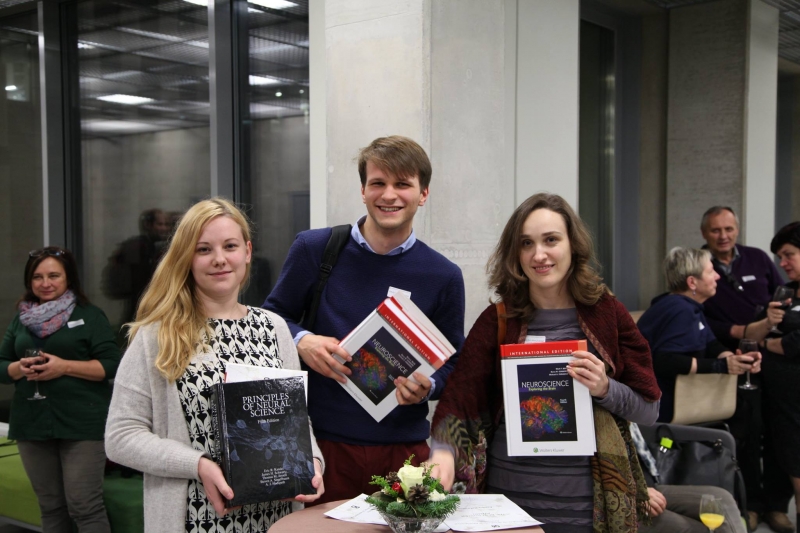The development of the nervous system is associated with the generation of excess neuronal synapses that is followed by their removal, a process known as synaptic pruning. Depending on the area of the brain, up to 70% of pre-formed synapses are lost during developmental circuit refinement. Why are so many synapses lost, what determines which synapses are eliminated, what are the molecular mechanisms involved, and what are the consequences of not getting it right? Appropriate synaptic pruning appears to be required for the strengthening of remaining synapses and is critical for normal brain development. In animal models, aberrations of synaptic pruning lead to impaired brain circuit maturation and dysfunctional connectivity. In human brain imaging and post-mortem studies, the reduction of brain volume and reduced density of dendritic spines in schizophrenia is suggestive of over-pruning, whereas increased brain volume and dendritic spine densities may indicate under-pruning in autism.
Unfortunately, the risks underlying these circuit disorders and the reason why synaptic pruning is required to achieve the final connectome is currently poorly understood. For a long time synaptic pruning has been seen as a neuron-autonomous process. However, recent studies revealed that unnecessary synapses may be phagocytosed by resident immune cells – microglia. In mouse models, microglia cells are recruited to the maturing brain regions by neuronal chemotactic protein fractalkine and eliminate synapses in a complement-dependent manner. But how do these systems function to selectively drive the elimination of some synapses over others?
For microglia to discriminate between subsets of synapses that need to be removed or maintained there must be molecular signal(s) that are exposed on the surface of the synapse to trigger or inhibit microglial recognition and engulfment. We aim to define molecular signaling pathways that drive this highly specific pruning of unnecessary synapses. For this we use both ex vivo tissue cultures and genetically modified mouse lines. High resolution fluorescent microscopy of developing circuits is supplemented with electrophysiology studies and animal behaviour experiments. We intend to define synapses destined for elimination in vitro and thereafter in vivo and to elucidate their molecular signatures, giving first direct insights into the molecular cascades that are required for developmental synaptic pruning in maturing circuits of the brain.
Group members
|
Group Leader Prof. Urtė Neniškytė
|
Senior Researcher Dr. Simonas Kutanovas
|
Research Associate Dr. Neringa Daugelavičienė |
|
Research Associate Dr. Ugnė Kuliešiūtė |
Research Associate Dr. Nemira Žilinskaitė |
PhD Student Gintarė Urbonaitė
|
|
PhD Student Lina Saveikytė
|
PhD Student Eimina Dirvelytė
|
PhD Student Ieva Šiugždaitė
|
Contacts
Prof. Urtė Neniškytė Dr. Simonas Kutanovas Dr. Neringa Daugelavičienė
This email address is being protected from spambots. You need JavaScript enabled to view it. This email address is being protected from spambots. You need JavaScript enabled to view it.This email address is being protected from spambots. You need JavaScript enabled to view it.neringa.daugelavičienė@gmc.vu.lt
tel. +370 (5) 223 4437 C516 kab. C516 kab.
Dr. Ugnė Kuliešiūtė Dokt. Gintarė Urbonaitė Dokt. Eimina Dirvelytė
This email address is being protected from spambots. You need JavaScript enabled to view it. This email address is being protected from spambots. You need JavaScript enabled to view it. eimina.dirvelytė@gmc.vu.lt
C543 kab. C543 kab. C543 kab.
Dokt. Ieva Šiugždaitė
This email address is being protected from spambots. You need JavaScript enabled to view it.
C543 kab.
Collaborators
Dr. Cornelius Gross, Mouse Biology Unit, European Molecular Biology Laboratory, Monterotondo, Italy.
Dr. Dieter Henrik Heiland, Dr. Vidhya Madapusi Ravi, Microenvironment and Immunology Research Laboratory, Department of Neurosurgery, University of Freiburg, Germany.
Dr. Vida Časaitė, Dr. Aurelijus Burokas, Vilnius University, Lithuania.
Dr. Etienne Herzog, CNRS Researcher, Interdisciplinary Institute for NeuroScience, Université de Bordeaux, Bordeaux, France.
Dr. Eiva Bernotienė and Dr. Jaroslav Denkovskij, Innovative Medicine Center, Vilnius, Lithuania.
Projects
ERA-NET NEURON Joint Transnational Call funding for the project “Neurobiological mechanisms of the environment - plasticity - behaviour interaction” at Vilnius University, Vilnius, Lithuania (2024-2027).
HORIZON-WIDERA-2023-ACCESS-04 – Pathways to Synergies funding for the project “Pan-European Network for Neuroscience Research Infrastructure and Strengthening of Support Capacities” at Vilnius University, Vilnius, Lithuania (2024-2026)
Programme "University Excellence Initiatives" of the Ministry of Education, Science and Sports of the Republic of Lithuania (Measure No. 12-001-01-01-01 "Improving the Research and Study Environment") for the project “Targeted CRISPR-Cas Delivery into Mammalian Nervous System” at Vilnius University, Vilnius, Lithuania (2024-2026).
Research Council of Lithuania funding for competitive PhD position for the project “The application of gene editing tools for monogenic lysosomal storage disorders” at Vilnius University, Vilnius, Lithuania (2023-2027).
European Regional Development Fund grant agreement No 01.2.2-CPVA-V-716-01-0001 with the Central Project Management Agency (CPVA), Lithuania for the project “Targeted CRISPR-Cas Delivery into Mammalian Nervous System” at Vilnius University, Vilnius, Lithuania (2021-2023).
Vilnius University Science Advancement Fund for the project “The impact of maternal metabolic status for the neurodevelopment of the offspring: detecting early behavioural deficits through ultrasonic vocalizations” at Vilnius University, Vilnius, Lithuania (2020).
Horizon 2020 Marie Sklodowska Curie Individual Fellowship for LIPSYNING project at Vilnius University, Vilnius, Lithuania (2016-2021).
Publications
Bujanauskiene D, Merkevicius K, Kuliesiute U, Denkovskij J, Kutanovas S, Luksys G, Rocka S, Bernotiene E, Neniskyte U. Integrity assay for messenger RNA in mouse and human brain samples and synaptosomal preparations. iScience. 2024 Jun 29;27(8):110419. doi: 10.1016/j.isci.2024.
Vaisvilas M, Petrosian D, Bagdonaite L, Taluntiene V, Kralikiene V, Daugelaviciene N, Neniskyte U, Kaubrys G, Giedraitiene N. Seroprevalence of neuronal antibodies in diseases mimicking autoimmune encephalitis. Sci Rep. 2024 Mar 4;14(1):5352. doi: 10.1038/s41598-024-55995-6.
Dirvelyte D, Pamedytyte D, Jankaityte E, Daugelaviciene N, Kisieliute U, Nagula I, Budvytyte R, Neniskyte U. Genetically encoded phosphatidylserine biosensor for in vitro, ex vivo and in vivo labelling. Cell Mol Biol Lett. 2023 Jul 27;28(1):59. doi: 10.1186/s11658-023-00472-7.
Gabrielaitis D*, Zitkute V*, Saveikyte L, Labutyte G, Skapas M, Meskys M, Casaite V, Sasnauskiene A†, Neniskyte U†. Nanotubes from bacteriophage tail sheath proteins: internalisation by cancer cells and macrophages. Nanoscale Adv, 2023 Jun 7;5(14):3705-3716. doi: 10.1039/D3NA00166K.
Kuliesiute U, Joseph K, Straele J, Ravi VM, Kueckelhaus J, Benotmane JK, Zhang J, Vlachos A, Beck J, Schnell O, Neniskyte U†, Dieter Henrik Heiland†. Sialic acid metabolism orchestrates transcellular connectivity and signalling in glioblastoma. Neuro-Oncology, 2023 Nov 2;25(11):1963-1975. doi: 10.1093/neuonc/noad101. †-shared last co-authorship.
Neniskyte U*, Kuliesiute U, Vadisiute A, Jevdokimenko K, Coletta L, Deivasigamani L, Pamedytyte D, Daugelaviciene N, Dabkeviciene D, Perlas E, Bali A, Basilico B, Gozzi A, Ragozzino D, Gross CT*. Phospholipid scramblase Xkr8 is required for developmental axon pruning. EMBO J, 2023 Jul 17;42(14):e111790. doi: 10.15252/embj.2022111790. * - corresponding authors.
Paolicelli RC, Sierra A, Stevens B, Tremblay EM, ... Neniskyte U, ..., Wyss-Coray T. Microglia states and nomenclature: A field at its crossroads. Neuron. 2022 Nov 2;110(21):3458-3483. doi: 10.1016/j.neuron.2022.10.020.
Urbonaite G, Knyzeliene A, Bunn FS, Smalskys A, Neniskyte U. The impact of maternal high-fat diet on offspring neurodevelopment. Front Neurosci. 2022 Jul 22;16:909762. doi: 10.3389/fnins.2022.909762.
Daugelaviciene N, Grigaitis P, Gasiule L, Dabkeviciene D, Neniskyte U, Sasnauskiene A. Lysosome-targeted photodynamic treatment induces primary keratinocyte differentiation. J Photochem Photobiol B. 2021 Mar 29;218:112183.
Weinhard L, di Bartolomei G, Bolasco G, Machado P, Schieber NL, Neniskyte U, Exiga M, Vadisiute A, Raggioli A, Schertel A, Schwab Y, Gross CT. Microglia remodel synapses by presynaptic trogocytosis and spine head filopodia induction. Nat Commun. 2018 Mar 26;9(1):1228
Weinhard L, Neniskyte U, Vadisiute A, di Bartolomei G, Aygün N, Riviere L, Zonfrillo F, Dymecki S, Gross C. Sexual dimorphism of microglia and synapses during mouse postnatal development. Dev Neurobiol. 2018 Jun;78(6):618-626.
Neniskyte U & Gross C. The errant gardener: glia -dependent developmental synaptic pruning and psychiatric disorders. Nat Rev Neurosci. 2017 Nov;18(11):658-670.
















